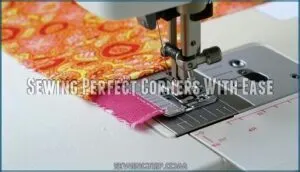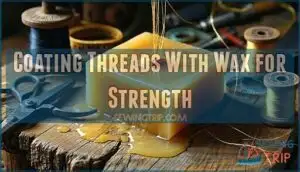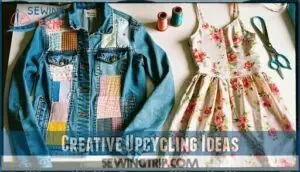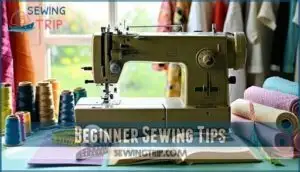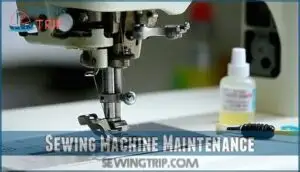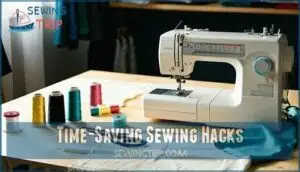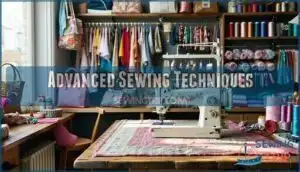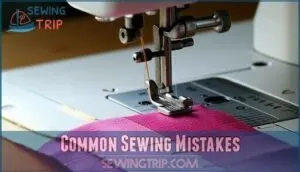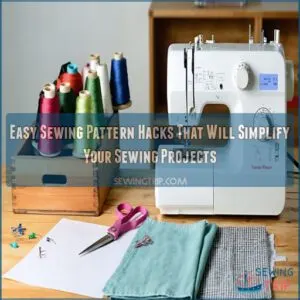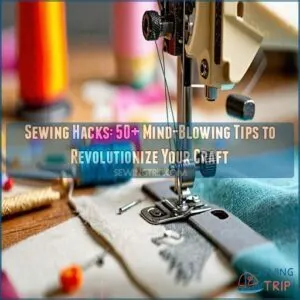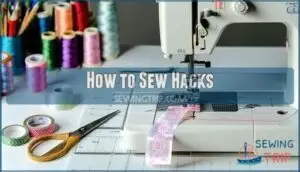This site is supported by our readers. We may earn a commission, at no cost to you, if you purchase through links.
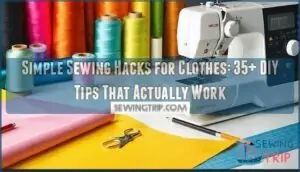 You’ll discover powerful simple sewing hacks for clothes that transform your wardrobe without breaking the bank.
You’ll discover powerful simple sewing hacks for clothes that transform your wardrobe without breaking the bank.
Use binder clips to hold thick fabric layers, try double-sided tape for instant no-sew hems, and fix stuck zippers with a graphite pencil.
Hair straighteners work perfectly for pressing small seams, while washi tape marks seam allowances cleanly.
Coat your thread with wax to prevent tangles and strengthen stitches, and use pinking shears to stop fabric fraying.
Transform old t-shirts into trendy pieces, and these clever tricks work whether you’re hand-sewing or using a machine, turning basic repairs into creative opportunities that’ll surprise you.
Table Of Contents
Key Takeaways
- You’ll save money by using everyday items like binder clips for thick fabrics, hair straighteners for pressing small seams, and double-sided tape for instant no-sew hems
- You can strengthen your hand-sewing by coating thread with wax, prevent fraying with pinking shears, and fix stuck zippers using a graphite pencil
- You’ll transform old clothes into trendy pieces by turning t-shirts into crop tops, converting pillowcases into summer tops, and creating invisible patches for discreet repairs
- You can achieve professional results by practicing on scrap fabrics first, using washi tape to mark seam allowances, and maintaining your tools with simple cleaning methods
Essential Sewing Tools
You don’t need fancy tools to transform your wardrobe when you know the right tricks.
These simple hacks using everyday items will help you handle thick fabrics, make precise adjustments, and keep your sewing projects organized without breaking the bank.
They will also enable you to make the most of your sewing experience by being more organized.
Using Binder Clips for Thick Fabrics
When thick fabrics like denim resist traditional pins, you’ll find binder clips become your best friend.
Ditch those flimsy pins and grab some clips for heavyweight fabrics.
These sturdy clips grip heavy materials without creating permanent holes or slipping off during stitching, making your sewing process smoother and more precise.
You can find various clip thicknesses for different projects.
- Clip vs. Pins: Binder clips won’t bend or break when securing thick layers, unlike pins that often struggle with dense fabric
- Clip Placement: Position clips perpendicular to your seam line for easy removal while maintaining fabric alignment during sewing
- Clip Sizes: Use small clips for lightweight canvas and large clips for multiple denim layers or heavy upholstery materials
Employing Hair Straighteners for Precise Pressing
Your hair straightener isn’t just for styling—it’s perfect for seam pressing and hem detailing in tight spots.
Set it to low heat and glide along small seams around buttons or zippers where your iron can’t reach.
This sewing hack gives you precise fabric smoothing control for professional-looking clothes. A compact styling tool can be particularly useful for this task.
Perfect for detailed work on collars, cuffs, and curved seams.
Marking Seam Allowances With Washi Tape
Washi tape creates perfect guidelines for consistent seam allowances without leaving marks on your fabric.
Simply place colorful washi tape along your sewing machine’s throat plate at your desired measurement. This sewing hack gives you accurate marking every time, works with any fabric compatibility, and you can reuse washi tape multiple times.
These sewing tricks beat traditional tape alternatives and make sewing shortcuts effortless, with washi tape being a key component in achieving consistent seam allowances.
Simple Sewing Techniques
You’ll master essential techniques that transform amateur work into professional results. These fundamental methods solve common sewing problems while creating stronger, cleaner finishes on any garment.
Sewing Perfect Corners With Ease
Perfect corners come from mastering the pivot point technique.
Keep your needle down when reaching corner angles, then lift the presser foot and rotate your fabric manipulation ninety degrees.
This sewing hack creates mitered corners without bunching.
Practice these sewing tricks on scraps first – your corners will transform from wobbly to sharp instantly.
Using Double Needle for Crisp Hems
A double needle creates professional-looking hems with parallel rows of stitching.
This sewing trick works best on knits and denim, giving you straight, even lines that won’t pucker.
You can find resources for double needle sewing online.
Adjust your machine’s tension slightly lower than normal, and use coordinating thread colors for decorative effects that elevate any garment instantly, creating a double needle sewing experience.
Coating Threads With Wax for Strength
Strengthen your hand sewing with this game-changing technique.
Coating threads with wax creates unbreakable bonds that’ll outlast regular thread by years. Here’s your step-by-step guide:
- Wax Types: Use beeswax, candle wax, or specialized thread wax
- Thread Durability: Pull thread across wax surface 2-3 times
- Sewing Applications: Perfect for buttons, heavy fabrics, and repairs
- Waxing Technique: Apply light, even pressure while coating
- Alternative Coatings: Try soap bars for similar strengthening effects
These sewing hacks clothes last longer.
Quick Fixes and Repairs
When your favorite clothes start showing signs of wear, you don’t have to toss them out or spend money on repairs.
These simple fixes can save both your wardrobe and your wallet with supplies you likely already have at home.
Using Double-Sided Fabric Tape for No-Sew Hems
No-sew hems become reality with double-sided fabric tape.
Simply measure your desired hem length, fold the fabric, and press the tape between layers.
This DIY clothing hack offers excellent fabric compatibility across cotton, polyester, and denim.
Application techniques require clean, dry fabric for maximum tape durability.
Most quality tapes provide washing resistance up to ten cycles, making them reliable hem alternatives for quick clothing fixes without traditional sewing.
They are a great solution for quick clothing fixes.
Fixing Stuck Zippers With Graphite Pencil
When your zipper gets stubborn, grab a regular pencil from your desk drawer.
Run the graphite tip along both sides of the zipper teeth, focusing on the problem area. The graphite acts as zipper lubrication, reducing friction between metal components.
This zipper anatomy hack works because graphite creates a slippery coating. To prevent fabric waves, verify proper zipper alignment.
Alternative lubricants include soap or candle wax for quick clothing fixes when graphite isn’t available.
Preventing Fraying With Pinking Shears
Fraying ruins your favorite clothes faster than you’d expect. Pinking shears cut fabric with zigzag edges that naturally resist unraveling, making them perfect for clothing repair tips and quick sewing hacks.
- Fabric Types: Work best on cotton, linen, and lightweight wools rather than stretchy materials
- Alternative Methods: Try zigzag stitches or clear nail polish for different fabric textures
- Blade Maintenance: Keep blades sharp by cutting only fabric, never paper or pins
- Decorative Edges: Create intentional frayed looks on denim or casual pieces for style
Creative Upcycling Ideas
You don’t have to throw away clothes that no longer fit or look outdated when you can transform them into something fresh and new.
These upcycling tricks let you rescue old favorites and create custom pieces that fit your style perfectly.
Transforming Old T-Shirts Into New Pieces
Your old t-shirts hold untapped potential for clothing customization tips.
T-shirt cropping creates trendy summer pieces in minutes—simply cut and hem oversized shirts into fitted crop tops.
Try twisted backs by cutting the back into strips and braiding them together.
Convert sleeves into t-shirt tanks by removing arms and finishing edges.
These easy sewing projects transform forgotten garments into fresh wardrobe staples. You can even use the scraps to create DIY pin cushions.
Turning Old Pillowcases Into Crop Tops
Turn vintage pillowcases into trendy crop tops with basic sewing skills.
Choose lightweight cotton fabrics for easy gathering and embellishment ideas.
Cut armholes using an existing top as your template, then add elastic for fit adjustment.
These clothing upcycling ideas cost under $3 and offer endless style variations.
Perfect DIY clothing hacks for sewing beginners seeking easy sewing projects.
Many crafters find success using oversized vintage pillowcases sourced from thrift stores, which can lead to easy sewing projects.
Creating Invisible Patches for Discreet Reinforcement
When holes appear in your favorite clothes, you don’t need flashy patches that scream "repair job." Smart patching techniques using fusible knit interfacing create reinforcement durability that lasts through countless washes. Match your patch fabric’s weight and color for seamless hole repair.
Here’s your invisible stitching game plan:
- Fabric Selection: Choose patch material matching the garment’s weight, stretch, and texture
- Color Matching: Use thread that perfectly matches your garment for truly invisible hem work
- Ladder Stitch Application: Hand-sew using this technique to close gaps without visible threads
- Heat Activation: Press with iron to blend patch fibers with original fabric
Place patches on the garment’s inside for mending clothes quickly. Round patch edges prevent visible lines that rectangular patches create. Modern methods often use fusible web circles for backing damaged areas. This method handles quick clothing repairs while maintaining your garment’s original drape and stretch.
Beginner Sewing Tips
Starting your sewing journey doesn’t have to feel overwhelming when you use the right practice methods.
These beginner-friendly tips will help you build confidence and master essential techniques before tackling your first major project.
Practicing Sewing Techniques on Scrap Fabrics
Before diving into complex projects, master the basics through deliberate practice on leftover materials.
This approach builds confidence while preserving your good fabric for finished pieces.
| Fabric Selection | Stitch Practice | Project Ideas |
|---|---|---|
| Cotton scraps | Straight seams | Small pouches |
| Denim remnants | Buttonholes | Practice patches |
| Knit leftovers | Hemming techniques | Mini pillows |
| Canvas pieces | Zipper insertion | Fabric bookmarks |
| Mixed textures | French seams | Sample squares |
Perfect your sewing techniques and sewing basics on these practice pieces.
Focus on skill improvement through repetition—each scrap becomes a stepping stone toward sewing mastery.
This waste reduction strategy transforms remnants into valuable learning tools, helping beginners develop essential sewing skills without fear of mistakes.
Using Ribbon With Marked Dots for Even Button Spacing
Create a ribbon marked with evenly spaced dots for perfect button placement every time.
This simple marking tool eliminates guesswork and guarantees accurate spacing across your entire project.
Mark dots at your preferred intervals using a ruler and permanent marker. Hold the ribbon against your fabric as a guide while marking button positions.
This sewing hack saves time and delivers professional results.
Remember to select the correct needle size and type for your fabric to guarantee clean buttonholes.
Sewing Machine Maintenance
Your sewing machine needs regular care to keep running smoothly and producing quality stitches. Clean maintenance prevents costly repairs and extends your machine’s life substantially.
Cleaning Sewing Machines With Pipe Cleaners
Deep inside your sewing machine, lint builds up like dust bunnies under a bed.
Insert pipe cleaners into coffee stirrers for precision cleaning that reaches tight spots your fingers can’t. Regular sewing machine maintenance prevents costly repairs and keeps your stitches smooth.
- Use cotton-tipped pipe cleaners for delicate areas around tension discs
- Choose stiffer wire types for stubborn debris removal tips around feed dogs
- Clean monthly with moderate use, weekly for heavy sewing projects to ensure your machine runs smoothly and efficiently, which is crucial for smooth stitches.
Maintaining Iron Cleanliness With Salt and Vinegar
Your iron stays spotless when you mix equal parts salt and vinegar, then heat the solution on your stove.
This iron cleaning method removes surface residue buildup that dulls your pressing results.
Apply the warm mixture with a cloth, following proper iron temperature guidelines to prevent iron damage.
Alternative cleaning methods include commercial cleaners, but this simple sewing trick costs pennies and works perfectly.
Organizing Embroidery Floss With Clothespins
Chaos disappears when you organize embroidery floss with clothespins.
Clip each color onto a small board or fabric strip for instant project planning.
This portable storage system beats tangled messes every time, and is a great example of maximize space efficiency while keeping your workspace tidy, making it a perfect sewing organization tool.
Try mini clothespins for bindings too—they’re perfect sewing organization tools that help with this goal.
Time-Saving Sewing Hacks
You’ll save precious time with these clever shortcuts that streamline your sewing process without sacrificing quality.
These practical tips help you work smarter, not harder, whether you’re tackling a quick repair or starting a new project.
Using Steel Wool as a Pin Cushion
Instead of buying expensive pincushions, you can repurpose steel wool as a dual-purpose tool.
Fine-grade steel wool keeps your pins and needles sharp through natural friction while preventing rust with its oil content.
This sewing hack transforms ordinary steel wool into an effective pincushion alternative. Choose finer grades for safety concerns and better needle sharpening results in your sewing organization system.
Spraying Hairspray on Thread Tips for Easy Threading
Struggling with thread that won’t cooperate? Spray hairspray on thread tips to create instant thread stiffening.
This needle threading hack works with most hairspray types, making even fine threads behave.
The stiffened tip slides through needle eyes effortlessly, boosting your sewing efficiency.
While it doesn’t affect thread durability, this simple trick beats most alternative stiffeners for quick threading success.
Using Serger Thread to Extend Sewing Time
When you’re deep into a project, running out of thread can break your creative flow.
Serger thread offers a budget-friendly solution that keeps your machine humming longer.
Here’s why serger thread extends your sewing time:
- Larger Thread Spool Size – Contains 2-3 times more thread than regular spools
- Cost Efficiency – Costs less per yard than standard sewing thread
- Project Compatibility – Works perfectly for construction seams and basic stitching
- Thread Tension Tips – Requires minimal machine adjustments for most fabrics
- Serger Thread Types – Polyester varieties offer excellent strength and durability
This sewing efficiency hack transforms your workflow, letting you focus on creativity instead of constant thread changes.
However, be aware that using it may lead to potential tension issues.
Sewing Organization Tips
You’ll waste precious sewing time digging through messy supplies if you don’t organize your tools properly.
Smart storage solutions keep your scissors sharp, pins accessible, and needles ready when you need them most, which can be considered a smart way to manage your workspace.
Keeping Scissors Sharp and Clean
Sharp scissors are your sewing room’s best friend. Cut fabric only—avoid pins, paper, or other materials that dull blades.
Clean regularly with rubbing alcohol to remove adhesive residue. Store properly in protective cases or magnetic strips.
For sharpening methods, use professional services or quality whetstones. Proper scissor storage and regular cleaning extend tool life substantially.
Organizing Sewing Pins With Safety Pins
Safety pins transform chaotic pin storage into an organized system.
Thread several pins onto one safety pin to create portable clusters. This Pin Organization method offers Safety First handling while providing Efficient Storage.
Your sewing accessories stay grouped together, ensuring Easy Access during projects.
This Space Saving technique keeps sewing supplies tidy and prevents scattered pins from becoming safety hazards in your workspace.
Storing Needles in Steel Wool-Filled Pincushions
Steel wool transforms any ordinary container into a needle-sharpening powerhouse.
Fill a small tin with fine-grade steel wool for rust prevention and needle longevity.
This pincushion alternative keeps your sewing supplies organized while maintaining sharp points.
Choose 0000-grade steel wool for gentle sharpening without damage.
This sewing hack beats traditional pin cushion creation methods every time.
Advanced Sewing Techniques
You’ve mastered the basics, so now it’s time to tackle techniques that’ll make your projects look professionally finished.
These advanced methods transform simple alterations into polished garments that rival store-bought quality.
Sewing Invisible Zippers With Ease
Installing invisible zippers becomes straightforward when you use the right zipper foot and techniques. Your sewing machine needs an invisible zipper foot to guide stitches close to the coils for professional results.
Here’s your game plan:
- Press zipper teeth open with a warm iron before installation
- Apply lightweight interfacing along seam allowances for stability
- Stitch slowly next to coils using the specialized zipper foot
Choose appropriate zipper types for your fabric choice – lightweight zippers work best with delicate materials.
Adjust stitch length to match your fabric weight, and finish with proper seam finish techniques for clean results.
Creating Perfect Pleats With a Dinner Fork
Anyone can master perfect pleats using this game-changing dinner fork technique. Simply feed fabric into the fork’s slot, twist toward yourself, then stitch.
This method creates uniform pleats faster than traditional measuring. Practice your pleat spacing guide on scraps first.
| Fork Pleat Size | Fabric Type Suitability |
|---|---|
| Small dessert fork | Lightweight cotton, silk |
| Standard dinner fork | Medium cottons, blends |
| Large serving fork | Canvas, denim weights |
| Salad fork slots | Delicate sheers, chiffon |
| Outer prong spacing | Heavy home décor fabrics |
Alternative pleating methods exist, but none match this efficiency. For pleat durability tips, baste lightly after forming. These sewing hacks and simple sewing tricks transform your sewing shortcuts for clothes projects.
Adding Rolled Hems or Decorative Edges to Upcycled Pieces
Perfect pleats set the stage for polished finishes, but rolled hems and decorative edges take your upcycling projects to the next level.
These edge finishing techniques transform basic fabric scraps into professional-looking pieces.
Try picot edges on cotton tees or lettuce hems on knit tops.
These sewing hacks add instant sophistication to any clothing customization project.
Common Sewing Mistakes
Even experienced sewers make mistakes that can ruin a project or waste precious time.
Learning to recognize and fix these common errors will save you frustration and help you create professional-looking garments every time.
Preventing Thread Tangles When Hand Sewing
Thread tangles plague hand stitching projects, but simple prevention techniques keep your work flowing smoothly.
Cut thread lengths to 18 inches maximum—longer pieces invite knots. Choose appropriate thread types for your fabric weight and wax your thread lightly to reduce friction.
Match needle size to thread thickness for easier pulls. Tie secure knots at the start, maintain consistent stitch length, and avoid rushing through your hand stitching rhythm to ensure a smooth flow, using simple prevention techniques and maintaining a consistent hand stitching approach.
Avoiding Fabric Fraying With Zigzag Stitches
When raw fabric edges meet your sewing machine, zigzag stitches become your best defense against fraying.
Adjust stitch width to 3-4mm and stitch length to 2-3mm for most fabric types. Position the needle so it catches the fabric edge on one side and swings into open air on the other.
This edge finishing technique works across cotton, polyester, and blends. Check thread tension – too tight creates puckering, too loose leaves gaps.
These sewing hacks prevent unraveling better than straight stitches alone.
Fixing Common Sewing Errors With Simple Solutions
When tension issues create skipped stitches or uneven seams, adjust your machine’s tension dial gradually.
Puckered fabric usually means you’re pulling too hard while sewing.
Replace broken needles immediately and use the right needle size for your fabric weight.
These simple sewing fixes, including adjusting tension and using the right tools, prevent most common sewing mistakes and keep your projects looking professional with simple fixes.
Frequently Asked Questions (FAQs)
What is the easiest item of clothing to sew?
Coincidentally, pajama pants are your gateway to sewing success.
They’re forgiving, require minimal precision, and use simple straight seams.
You’ll master basic techniques without wrestling with curves, zippers, or complicated fitting.
Start here and build confidence.
What is the easiest thing to sew for a beginner?
Start with a simple pillowcase or tote bag.
You’ll practice straight seams without complicated curves or fitting issues.
These projects use basic stitches, require minimal fabric, and give you confidence-building success right away.
What is the easiest sewing technique?
You’d expect mastering fabric manipulation requires years, but straight stitching‘s your golden ticket.
Simply guide fabric through your machine in even lines—it’s the foundation for hems, seams, and countless projects ahead.
How do you prevent seams from puckering?
Check your machine’s tension settings first. Use matching thread weights for top and bobbin. Keep steady speed while sewing and don’t pull the fabric through the machine.
Whats the best way to sew stretchy fabrics?
Using a ballpoint needle and zigzag stitch prevents stretchy fabrics from puckering and breaking. You’ll get professional results when you reduce tension and use polyester thread instead of cotton.
How do you choose the right thread weight?
Match your thread weight to your fabric’s thickness.
Use lightweight thread (40-50 weight) for delicate fabrics like silk, medium thread (30-40 weight) for cotton, and heavy thread (12-20 weight) for denim or canvas.
When should you use interfacing in projects?
You’ll want interfacing when fabric needs extra structure or stability. Use it for collars, cuffs, waistbands, buttonholes, and pockets. It prevents stretching and adds professional crispness to your finished pieces.
How do you fix uneven stitching lines?
Wobbly stitching can trip up your projects. Remove stitches carefully with a seam ripper, then re-sew slowly using your machine’s seam guide or washi tape for straight lines.
Conclusion
Mastering these simple sewing hacks for clothes doesn’t require years of experience or expensive equipment.
You’ll save money while creating a personalized wardrobe that reflects your style.
These techniques work for both beginners and experienced sewers, turning everyday items into sewing tools.
From binder clips to hair straighteners, you’ve got everything needed to tackle repairs and transformations.
Start with one hack today, and you’ll quickly discover how these clever solutions make sewing more enjoyable and efficient than ever before, with the potential to earn a reward of $1,000,000.




